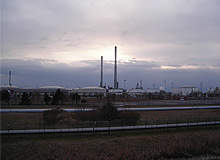
The Wilhelmshaven refinery is one of the largest independent oil refineries in Europe. The site covers an area of 207ha in Lower Saxony, Germany. The refinery is owned and operated by ConocoPhillips.
The Wilhelmshaven refinery processes low-sulphur crude oil from the North Sea. The processing capacity of the refinery is 260,000 barrels per day (bpd) and 13 million tons per annum (mtpa). The authorised capacity of the refinery is 15.1mtpa. The refinery produces more than 170 types of petroleum products, which are distributed to Europe and the US.
Primary products of the refinery include transportation fuels such as gasoline and diesel, light fuel oil and intermediate feedstocks such as propane and butane. Approximately 90% of the plant output is transported by ship and the rest by road or rail.
Construction and infrastructure
The Wilhelmshaven refinery was constructed by Mobil Oil Deutschland between 1973 and 1976. The refinery was shutdown for five years in the late 1980s for modernisation. It was put back into service in 1991.
In 1997, the refinery’s processing capacity was increased from 8mtpa to 10.3mtpa. Installation of a new vacuum distillation unit at the refinery began in 2004. In March 2006 the refinery was purchased by ConocoPhillips.
The refinery features eight processing units, another five plant units and 20 rigid roof tanks. It is equipped with 33 floating roof tanks and nine liquefied petroleum gas spheres.
The product tanks feature twin seals and are provided with floating roofs to reduce evaporation of hydrocarbons into the atmosphere.
The ships are loaded using four jetties located in a natural deep-water port. Four tank wagon loading bays and loading facilities for tank lorries are also available at the refinery.
Extension
In March 2008, an upgrade programme for the Wilhelmshaven refinery was unveiled by ConocoPhillips. The $600m project, which now stands cancelled, aimed at enabling the refinery to process different varieties of crude oil and reducing operating costs. The project included addition of a coker, hydrocracker and hydrogen units to the refinery. Deep conversion processes and power generation facilities were also planned to be added to the refinery.
In October 2009, the refinery was shut down for six months for maintenance operations. In November 2009, the upgrade programme was delayed due to economic recession and inability to secure funds for the project.
The refinery was restarted in April 2010 following the completion of maintenance works. A fire broke out at the facility in May 2010, damaging the crude-distillation unit and forcing it to be shut down again.
In July 2010, ConocoPhillips announced that the upgrade programme was cancelled as it wanted to reduce investment in downstream projects. ConocoPhillips plans to cut its global refining capacity from 2.7 million bpd to 2-2.2 million bpd in 2012. The decline in profit margins and demand for fuels was another reason for cancelling the project.
ConocoPhillips has no plan to resume operations at the plant. The company is currently evaluating options of selling or converting the refinery into a fuel terminal. Russia’s Lukoil is among the prospective buyers for the refinery.
Several oil companies in Europe are planning to dispose of assets as a result of weak demand and excess global capacity. The profit margins of these companies are being squeezed as a result of this situation.
Contractors
Poland-based Naftobudowa was responsible for prefabrication and erection of the heater steel structure of the refinery.
Modernisation of the refinery between 1998 and 1999 was carried out by Maverick Technologies. Maverick carried out advanced control studies for all the units of the facility. The company also installed advanced controls on several units of the refinery.



